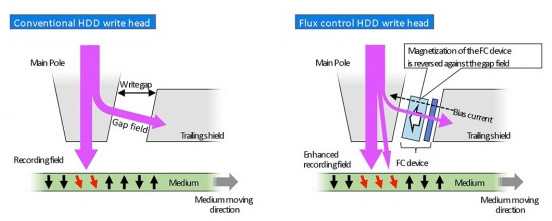Toshiba Microwave-Assisted Recording Technology Promises High-Density HDD Performance
Flux control effect in MAMR exploited to improve recording field in HDD
This is a Press Release edited by StorageNewsletter.com on March 15, 2021 at 2:31 pmResearchers at Toshiba Corporation in Japan have studied the operation of a small device fabricated in the write gap of a hard disk drive’s write head to extend its recording density.
Comparison between conventional HDD write head and newly proposed flux control HDD write head. In the flux control HDD write head, the magnetization of the FC device is reversed against the gap field by spin-transfer torque. The reversed magnetization decreases the magnetic flux inside the write gap and increases the one outside the write gap, enhancing both the amplitude and gradient of the recording field.
(Image: Hirofumi Suto)
The device, developed by HWY Technologies, is based on a design concept known as microwave-assisted magnetic recording, or MAMR.
This technology, reported in the Journal of Applied Physics, by AIP Publishing, uses a microwave field generator known as a spin-torque oscillator. The spin-torque oscillator emits a microwave field causing the magnetic particles of the recording medium to wobble the way a spinning top does. This makes them much easier to flip over when the write head applies a recording magnetic field in the writing process.
In a computer’s hard drive, each bit of data is stored in magnetic particles known as grains. The magnetic orientation of the grains determines whether the bit is a 0 or a 1.
Making the grains smaller allows them to be packed together more tightly. This increases the storage capacity, but it also makes the data bits unstable. The development of MAMR allows more stable magnetic materials to be used but also limits the type of recording media that can be developed.
The investigators focused on another effect known as the flux control (FC) effect, which also occurs in MAMR. This effect improves the recording field and is maximized when the magnetization of the spin torque oscillator is completely reversed against the gap field.
The advantage of the FC effect is that improvement is obtained in any magnetic recording, according to author Hirofumi Suto. This is significant, since it would no longer be necessary to use recording media specially designed for the MAMR technology.
The FC device, a type of spin-torque oscillator designed to maximize the FC effect, consists of two magnetic layers fabricated directly in the write gap of the write head. A bias current supplied to the device reverses the magnetization of one of the layers through an effect known as spin-transfer torque.
The investigators experimented with different bias currents and found the reversal of magnetization occurred more quickly at higher currents. Upon comparing their experiments to a computational model, they also determined the recording field was enhanced by the FC effect, improving the writability of the write head and exceeding the performance of conventional write heads.
The FC device operates effectively at a fast write rate of approximately 3Gb/s, according to Suto. These results provide evidence that the FC device operates as designed and show that FC-MAMR is a promising technology for extending the areal density of hard disk drives.
Toshiba plans to introduce hard disk drives using MAMR technology that will increase HDD capacity to 16-18 terabytes.
Article: Magnetization dynamics of a flux control device fabricated in the write gap of a hard-disk-drive write head for high-density recording
Journal of Applied Physics has published an article written by Hirofumi Suto, Masayuki Takagishi, Naoyuki Narita, Hitoshi Iwasaki, Tazumi Nagasawa, Corporate Research and Development Center, Toshiba Corporation, Kawasaki, 212-8582, Japan, Gaku Koizumi, Akihiko Takeo, Toshiba Electronic Devices and Storage Corporation, Yokohama, 235-8522, Japan, and Tomoyuki Maeda, Corporate Research and Development Center, Toshiba Corporation, Kawasaki, 212-8582, Japan.
Abstract: “The design concept of microwave-assisted magnetic recording (MAMR) using the flux control (FC) effect has been proposed as a technology for hard disk drives (HDDs). In this type of MAMR, the magnetization of an in-gap device (FC device) is reversed against the gap field by spin-transfer torque, enhancing the amplitude and gradient of the recording field. In this paper, we study the magnetization dynamics of an FC device fabricated in the write gap of an HDD write head. The operation of the FC device is analyzed by measuring the temporal resistance change in the sub-nanosecond region. Reversal of the FC device becomes faster as the bias current is increased and can be completed by 0.5 ns after the transition of the write current. The experimental results are reproduced by micromagnetic simulations using a head model, confirming that the simulations correctly describe the magnetization dynamics of the actual device. The simulations show that the recording field gain by the FC device appears with little delay after the rise of the recording field and that the FC device operates effectively even at a fast write rate of approximately 3 Gbit/s. Furthermore, we demonstrate the effectiveness of boosting the bias current, which can realize both fast and reliable operation of the FC device. These results indicate that the FC device operates as designed and that MAMR using the FC effect is promising for extending the recording density of HDDs.“














 Subscribe to our free daily newsletter
Subscribe to our free daily newsletter

